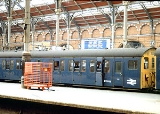
British Rail Class 307
Encyclopedia
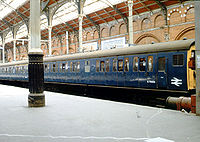
British Rail
British Railways , which from 1965 traded as British Rail, was the operator of most of the rail transport in Great Britain between 1948 and 1997. It was formed from the nationalisation of the "Big Four" British railway companies and lasted until the gradual privatisation of British Rail, in stages...
Class 307 electric multiple unit
Electric multiple unit
An electric multiple unit or EMU is a multiple unit train consisting of self-propelled carriages, using electricity as the motive power. An EMU requires no separate locomotive, as electric traction motors are incorporated within one or a number of the carriages...
s were built by BR at Eastleigh Works from 1954-1956. They were initially classified as AM7 before the introduction of TOPS
TOPS
Total Operations Processing System, or TOPS, is a computer system for managing the locomotives and rolling stock owned by a rail system...
.
Description
Thirty-two of these 4-car units were built for services on the Great Eastern Main LineGreat Eastern Main Line
The Great Eastern Main Line is a 212 Kilometre major railway line of the British railway system, which connects Liverpool Street in the City of London with destinations in east London and the East of England, including Chelmsford, Colchester, Ipswich, Norwich and several coastal resorts such as...
. The units were constructed to a similar design to the third-rail Class 415
British Rail Class 415
British Rail Class 415 was a suburban 750 V DC third rail electric multiple unit commissioned by the Southern Region of British Railways. Built between 1951 and 1957, it became the most numerous class on the region after the withdrawal of the 4Subs...
(4EPB) units introduced by the Southern Region a few years earlier. However there were several differences, most notably a slightly different front cab and a different seating arrangement.
All units were formed of four cars. When originally built, units were numbered in the range 01s-32s, and were composed of two outer driving trailers, an intermediate trailer composite (i.e. with some first-class seating), and an intermediate motor brake. The units were constructed to operate off the 1,500 V
Volt
The volt is the SI derived unit for electric potential, electric potential difference, and electromotive force. The volt is named in honor of the Italian physicist Alessandro Volta , who invented the voltaic pile, possibly the first chemical battery.- Definition :A single volt is defined as the...
direct current
Direct current
Direct current is the unidirectional flow of electric charge. Direct current is produced by such sources as batteries, thermocouples, solar cells, and commutator-type electric machines of the dynamo type. Direct current may flow in a conductor such as a wire, but can also flow through...
(DC) overhead power system used on Eastern Region suburban lines. However, in the late 1950s and early 1960s, these lines were converted to the 6.25 kV/25 kV alternating current
Alternating current
In alternating current the movement of electric charge periodically reverses direction. In direct current , the flow of electric charge is only in one direction....
(AC) overhead system, which was adopted as standard, and coincided with the introduction of new Class 302 (AM2)
British Rail Class 302
The British Rail Class 302 was a type of electric multiple unit introduced between 1958 - 1960 for outer suburban passenger services on the London, Tilbury and Southend Railway route...
units. Therefore, from 1960-1962 the entire AM7 fleet was extensively rebuilt at Eastleigh Works to allow units to operate from the new voltage system. The work including moving the guard's compartment from the motor coach to one of the driving trailers. At the same time, units were renumbered into the range 101-132.
From 1983-1984 the fleet was refurbished. Work involved replacing all compartments with open saloons, and the fitting of gangways between vehicles within a unit. The first-class seating was also moved from the trailer to the non-brake driving trailer. During this period, units were renumbered under the TOPS
TOPS
Total Operations Processing System, or TOPS, is a computer system for managing the locomotives and rolling stock owned by a rail system...
system to 307101-307132.
Details of the vehicle designations are shown below.
| Vehicle Numbers | As-built (1954) |
Rebuilt (1960) |
Refurbished (1983) |
|---|---|---|---|
| 75001-75032 | DTSO | DTBS | DTBSO |
| 61001-61032 | MBS | MS | MSO |
| 70001-70032 | TCOL | TCOL | TSOL |
| 75101-75132 | DTSsoL | DTSsoL | DTCOL |
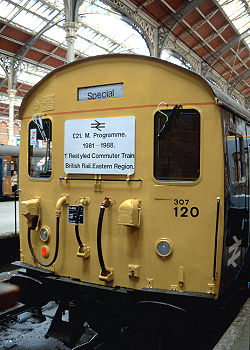 |
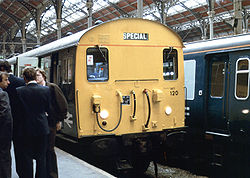 |
 |
 |
Operations
When new, these trains were used on the newly electrified Great Eastern Main LineGreat Eastern Main Line
The Great Eastern Main Line is a 212 Kilometre major railway line of the British railway system, which connects Liverpool Street in the City of London with destinations in east London and the East of England, including Chelmsford, Colchester, Ipswich, Norwich and several coastal resorts such as...
, running between Liverpool Street
Liverpool Street station
Liverpool Street railway station, also known as London Liverpool Street or simply Liverpool Street, is both a central London railway terminus and a connected London Underground station in the north-eastern corner of the City of London, England...
and Southend Victoria
Southend Victoria railway station
Southend Victoria is one of two major railway stations in the town of Southend-on-Sea in Essex, England. The station is the terminus of the Shenfield to Southend Line, which is a branch of the Great Eastern Main Line...
on semi-fast services. In 1960 the electrification system on this route was change from 1,500 V DC to 25 kV AC overhead, necessitating the rebuild of the fleet.
Following refurbishment in 1983, the fleet saw continued use on both the London, Tilbury and Southend Railway
London, Tilbury and Southend Railway
The London, Tilbury and Southend Railway is an English railway line linking Fenchurch Street railway station in the City of London with northeast London and the entire length of the northern Thames Gateway area of southern Essex. It is currently known as the Essex Thameside Route by Network Rail...
(LTS) and Great Eastern routes. From 1986, a few trains were repainted in Network SouthEast
Network SouthEast
Network SouthEast was one of three passenger sectors of British Rail created in 1982. NSE principally operated commuter trains in the London area and inter-urban services in densely populated South East England, although the network reached as far west as Exeter...
livery. By 1990, however, the class had been displaced from the LTS route by Class 310
British Rail Class 310
The British Rail Class 310 is a slam-door, alternating current electric multiple unit introduced in 1963 as part of the West Coast Main Line electrification project. They were initially classified as Class AM10 units before the introduction of the TOPS classification system. Constructed at BR's...
trains, themselves cascaded from the West Coast Main Line
West Coast Main Line
The West Coast Main Line is the busiest mixed-traffic railway route in Britain, being the country's most important rail backbone in terms of population served. Fast, long-distance inter-city passenger services are provided between London, the West Midlands, the North West, North Wales and the...
following introduction of new Class 321/4
British Rail Class 321
The British Rail Class 321 alternating current electric multiple units were built by BREL York in three batches from 1988-91. The design was successful and led to the development of the similar Class 320 and Class 322 units for use by Strathclyde PTE and Stansted Express respectively...
trains, supplemented temporarily by Class 317
British Rail Class 317
The British Rail Class 317 alternating current electric multiple units were built by BREL York in two batches, from 1981-82 and 1985-87. They were the first of several classes of British Rail EMU to be based on the all-steel Mark 3 bodyshell, departing from the "PEP"-aluminium design which had...
trains. The Class 307 trains did not last much longer on the Great Eastern route, following the introduction of new Class 321/3 and cascaded Class 312
British Rail Class 312
The British Rail Class 312 is a type of alternating current electric multiple unit built in 1975-1978 for use on outer-suburban passenger services. It was the last class of multiple unit to be constructed with the British Rail Mark 2 bodyshell, and also the last with slam doors...
trains.
By 1991, all Class 307 trains had been withdrawn from Netwrok SouthEast services. However, five trains (307105/111/120/122/130) were overhauled at Doncaster Works for use on the newly electrified Wakefield Line
Wakefield Line
The Wakefield line is the name given to one of the rail services in the West Yorkshire Metro/South Yorkshire P.T.E. area of northern England. The service connects Leeds and Wakefield with Sheffield and Doncaster. The section of the line between Leeds and Doncaster forms part of the East Coast Main...
service between Leeds and Doncaster
Doncaster railway station
Doncaster railway station serves the town of Doncaster, in South Yorkshire, England. It is situated on the East Coast Main Line north of London Kings Cross, and is about five minutes walk from Doncaster town centre. The station is managed by East Coast...
. They received the West Yorkshire Metro
West Yorkshire Passenger Transport Executive
The West Yorkshire Passenger Transport Executive is the Passenger Transport Executive for the county of West Yorkshire, England. It is the executive arm of the West Yorkshire Integrated Transport Authority and was originally formed on 1 April 1974 as the West Yorkshire Passenger Transport...
maroon livery. The use of these units was intended as a stop-gap until three new Class 321/9
British Rail Class 321
The British Rail Class 321 alternating current electric multiple units were built by BREL York in three batches from 1988-91. The design was successful and led to the development of the similar Class 320 and Class 322 units for use by Strathclyde PTE and Stansted Express respectively...
trains entered service. The final Class 307 trains were withdrawn in early 1993.
Following withdrawal, large-scale scrapping of the class was delayed as it was intended to rebuild the units as Class 300
British Rail Class 300
Class 300 was allocated to a proposed fleet of parcels-carrying electric multiple units, which were to be converted from former Class 307 units.In the early 1990s, the Class 307 passenger units were being withdrawn from service...
parcels units. This plan was dropped in favour of building new Class 325
British Rail Class 325
The British Rail Class 325 is a 4 car dual-voltage 25 kV alternating current or 750 V direct current electric multiple unit train used for postal train services. They are based on the Class 319. The Class 325 was British Rail's newest unit to take over parcels working on electrified...
units. However, many of the driving trailer vehicles were eventually rebuilt as Propelling Control Vehicle
Propelling Control Vehicle
A Propelling Control Vehicle is a type of British railway carriage for carrying mail. They were converted from Class 307 driving trailers and have a cab at one end. This allows mail trains to be propelled at low speed, with the locomotive at the rear of the train being driven from the...
s (see below). The redundant intermediate trailers and motor vehicles were eventually scrapped.
Departmental use
Following withdrawal from service, several units were converted for further use as departmental vehicles. These are listed below.Crash tests
Units 307101, 307106 and 307121 were used a crash-test units at Old Dalby, for use in simulated crashes for safety purposes.Class 316 testbed unit
Unit 307118 was converted into a test unit for the 'Holec' three-phase AC traction motors and associated electrical gear used in the Class 323British Rail Class 323
The British Rail Class 323 electric multiple units were built by Hunslet TPL from 1992-93. Forty-three 3-car units were built for inner-suburban services around Birmingham and Manchester...
EMUs. As 316998, the BDTBSO coach had its seating removed and the electrical equipment mounted in the passenger cabin and cooling provided via a large grill fitted in place of the guard's doors on the left hand side. The pantograph well was also revised, bringing it closer towards the cab.
Later, the unit was altered for 750 V DC third rail
Third rail
A third rail is a method of providing electric power to a railway train, through a semi-continuous rigid conductor placed alongside or between the rails of a railway track. It is used typically in a mass transit or rapid transit system, which has alignments in its own corridors, fully or almost...
operation, the pickup shoes being mounded on the former MSO and renumbered 316997. After testing, the unit was stored at the back of Eastleigh T&RSMD. Scrapping took place at Caerwent
Caerwent
Caerwent is a village and community in Monmouthshire, Wales. It is located about five miles west of Chepstow and eleven miles east of Newport, and was founded by the Romans as the market town of Venta Silurum, an important settlement of the Brythonic Silures tribe. The modern village is built...
in July 2006.
Postal conversions
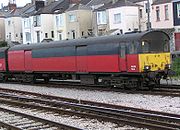
British Rail
British Railways , which from 1965 traded as British Rail, was the operator of most of the rail transport in Great Britain between 1948 and 1997. It was formed from the nationalisation of the "Big Four" British railway companies and lasted until the gradual privatisation of British Rail, in stages...
parcels sector Rail Express Systems
Rail Express Systems
Upon the sectorisation of British Rail during the 1980s the Parcels Sector was created. In 1991 this was rebranded Rail Express Systems. The Rail Express Systems launch event was held at Crewe Diesel Depot in October 1991. For this event examples of Class 08, 47, 86 & 90 locomotives were painted...
identified the need for driving trailers to operate in push-pull
Push-pull train
Push–pull is a mode of operation for locomotive-hauled trains allowing them to be driven from either end.A push–pull train has a locomotive at one end of the train, connected via some form of remote control, such as multiple-unit train control, to a vehicle equipped with a control cab at the other...
mode with a locomotive. This would remove the time consuming process of changing the locomotive to other end of the train to allow it to leave a terminus. These new vehicles were called Propelling Control Vehicle
Propelling Control Vehicle
A Propelling Control Vehicle is a type of British railway carriage for carrying mail. They were converted from Class 307 driving trailers and have a cab at one end. This allows mail trains to be propelled at low speed, with the locomotive at the rear of the train being driven from the...
s (PCVs), since it was envisaged that they would only be used to propel a train into or out of a terminus, and not used at high-speed or over long distances.
It was decided to convert the vehicles from the many redundant Class 307 vehicles that were stored at various locations around the country. In 1994, two vehicles were rebuilt as prototype PCV vehicles, and underwent an extensive testing procedure. In the period 1994-1996, a further 40 redundant driving trailer vehicles were rebuilt by Hunslet-Barclay in Kilmarnock
Kilmarnock
Kilmarnock is a large burgh in East Ayrshire, Scotland, with a population of 44,734. It is the second largest town in Ayrshire. The River Irvine runs through its eastern section, and the Kilmarnock Water passes through it, giving rise to the name 'Bank Street'...
.
The rebuilding work included removal of the windows and slam-doors, the fitting of roller-shutter doors, and modernisation of the cab. The vehicles were given the TOPS
TOPS
Total Operations Processing System, or TOPS, is a computer system for managing the locomotives and rolling stock owned by a rail system...
code NAA and were numbered in the range 94300-327 (for former DTCOL vehicles) and 94331-345 (for former DTBSO vehicles).
Vehicle nos. 94300/301 were the prototype Propelling Control Vehicles. Due to their non-standard nature, they have since had their push-pull equipment isolated and are used as standard parcels vans. To reflect this change, the two vehicles have been renumbered to 95300/301.
Details of the vehicles converted to PCVs are shown below.
| Original no. | Former vehicle type | New PCV no. | Comments |
|---|---|---|---|
| 75004 | DTBSO | 94345 | - |
| 75005 | DTBSO | 94342 | - |
| 75007 | DTBSO | 94341 | - |
| 75008 | DTBSO | 94338 | - |
| 75011 | DTBSO | 94332 | - |
| 75012 | DTBSO | 94340 | - |
| 75014 | DTBSO | 94344 | - |
| 75016 | DTBSO | 94333 | - |
| 75017 | DTBSO | 94334 | - |
| 75022 | DTBSO | 94331 | - |
| 75024 | DTBSO | 94339 | - |
| 75027 | DTBSO | 94343 | - |
| 75029 | DTBSO | 94337 | - |
| 75031 | DTBSO | 94336 | - |
| 75032 | DTBSO | 94335 | - |
| 75102 | DTCOL | 94301 | Since renumbered to 95301 |
| 75103 | DTCOL | 94324 | - |
| 75104 | DTCOL | 94305 | - |
| 75105 | DTCOL | 94311 | - |
| 75107 | DTCOL | 94304 | - |
| 75108 | DTCOL | 94316 | - |
| 75109 | DTCOL | 94314 | - |
| 75110 | DTCOL | 94323 | - |
| 75111 | DTCOL | 94322 | - |
| 75112 | DTCOL | 94306 | - |
| 75113 | DTCOL | 94325 | - |
| 75114 | DTCOL | 94300 | Since renumbered to 95300 |
| 75115 | DTCOL | 94318 | - |
| 75116 | DTCOL | 94327 | - |
| 75117 | DTCOL | 94317 | - |
| 75119 | DTCOL | 94310 | - |
| 75120 | DTCOL | 94320 | Preserved, Mid-Norfolk Railway Mid-Norfolk Railway The Mid-Norfolk Railway or MNR is a heritage railway in the English county of Norfolk. Opening as a tourist line in 1997, it is often referred to as a "New Generation" heritage railway.... |
| 75122 | DTCOL | 94321 | - |
| 75123 | DTCOL | 94326 | - |
| 75124 | DTCOL | 94302 | - |
| 75125 | DTCOL | 94308 | - |
| 75126 | DTCOL | 94312 | - |
| 75127 | DTCOL | 94307 | - |
| 75128 | DTCOL | 94319 | - |
| 75129 | DTCOL | 94313 | - |
| 75130 | DTCOL | 94309 | - |
| 75131 | DTCOL | 94303 | - |
| 75132 | DTCOL | 94315 | - |
Carriage nos. 94303/07/10/11/15/16/17/20/22/31/34/36/37/38/39/40/ have been sold for scrap to CF Booths, and carriage nos. 94305/09/19/21/25/41/42/45 to TJ Thompson.
Preservation
One driving Brake trailer from unit 307123 has been saved for preservation.- 75023 - Electric Railway Museum, BagintonCoventry Railway CentreThe Electric Railway Museum is located in Warwickshire, south of Coventry city, outside Baginton, and near to Coventry Airport. The heritage railway centre was also known as "The Airfield Line" as the railway was built on the site of a greenfield...
(website). Restoration ongoing.
One PCV conversion has also been saved for preservation.
- 94320 - Mid-Norfolk RailwayMid-Norfolk RailwayThe Mid-Norfolk Railway or MNR is a heritage railway in the English county of Norfolk. Opening as a tourist line in 1997, it is often referred to as a "New Generation" heritage railway....
(website). Under restoration as stores vehicle.
One vehicle, DTBSO no. 75018 (ex-977708) was bought by the AC Loco Group at Barrow Hill Engine Shed
Barrow Hill Engine Shed
Barrow Hill Roundhouse & Railway Centre, until 1948 known as Staveley Roundhouse & Train Centre, is a former Midland Railway roundhouse in Barrow Hill, near Staveley and Chesterfield, Derbyshire .-History:...
for spares recovery. It was scrapped at Caerwent MOD
Ministry of Defence (United Kingdom)
The Ministry of Defence is the United Kingdom government department responsible for implementation of government defence policy and is the headquarters of the British Armed Forces....
in 2006.

